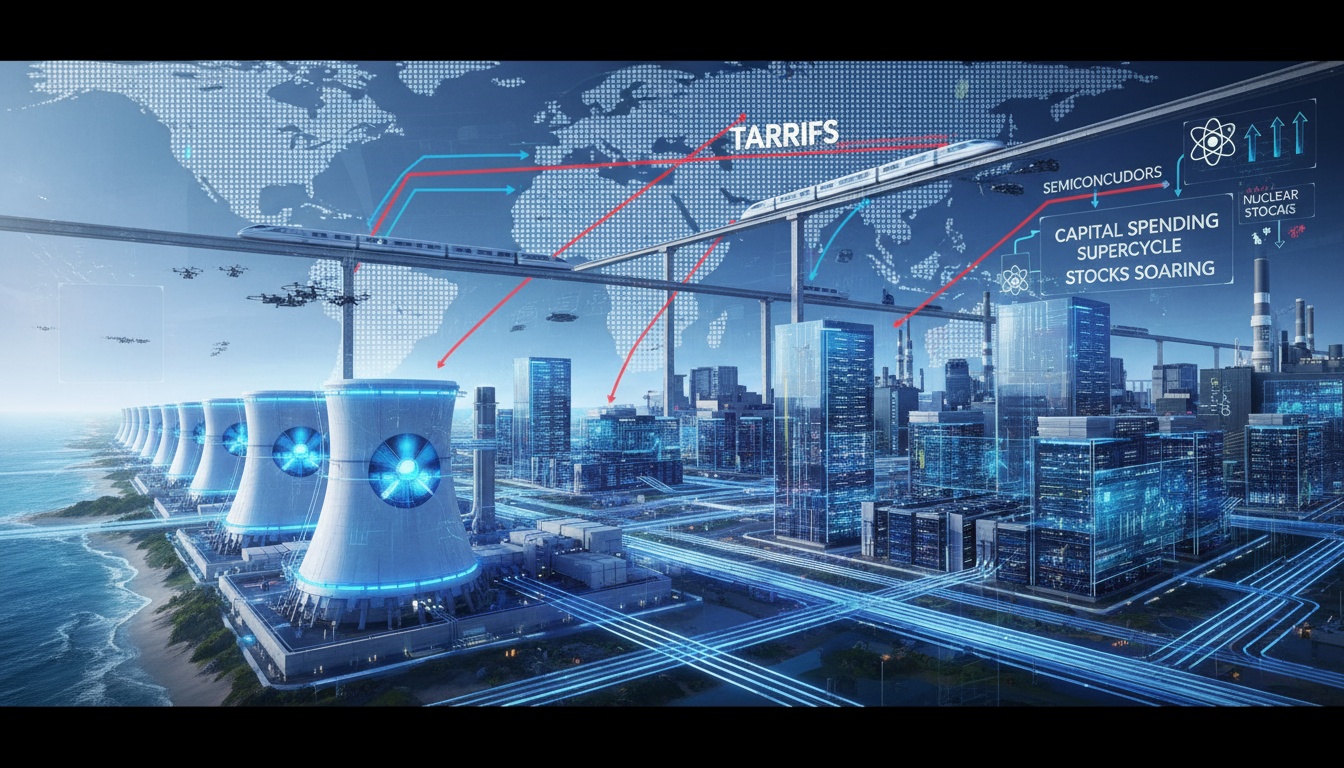● AI Goldrush, Tariff Truce, Power Crunch, ETF Timebomb
Nasdaq ‘Strong-Weak-Strong-Weak’ Pattern, US-China Tariff Deferment Signal, AI-Semiconductor Cycle Confirmed by ASML Orders, Texas Data Center = Energy Factory, Hidden Risks of High-Leverage ETFs Sorted Out
Today’s post contains 5 key points that can be immediately applied.
- Explains why the Nasdaq moves in a ‘strong-weak-strong-weak’ rhythm even with a single line of news, interpreting the structure from a market microstructure perspective.
- Outlines the reasons behind the US-China conflict being at a crossroads of “tariff deferment vs. reimposition” and why the fentanyl issue becomes a stock price variable.
- Explains why ASML’s new orders serve as a real-time barometer for the AI infrastructure–semiconductor boom, along with the numbers and their significance.
- Details that the real reason behind the Texas data center rush is ‘electricity’; outlining key points from natural gas, SMR, to PPA that can resolve energy bottlenecks.
- Provides a structural understanding of why the 5x leverage ETF, favored by Korean investors, is attractive yet carries a high risk of delisting.
[Breaking News] Nasdaq’s ‘Strong-Weak-Strong-Weak’ Pattern: The Mismatch of US-China News and AI Momentum
Recently, the Nasdaq has been repeating a rhythm of down-up-down-up.
Two main triggers can be identified:
- The direction of US-China conflict headlines. A signal of easing triggers a rally in risk assets, while a worsening signal leads to immediate adjustments.
- Performance and investment news from the artificial intelligence sector. Positive momentum in semiconductors, data centers, and cloud-related news defends the buying side.
This pattern is not simply a matter of sentiment.
- Headline-driven short-term volatility generated by macroeconomic news (especially US-China) causes options and futures positions to react sensitively, often reversing intraday trends.
- As the day progresses towards the end, the confluence of headlines and quant positioning often leads to increased volatility.
US-China Tariffs and Fentanyl: The Market Impact of the ‘6-Month Deferment’ Card
Recently, a message emerged from the US side stating that “if China cooperates in resolving the fentanyl issue, tariffs could be deferred for 6 months.”
- Tariff deferment is positive for global supply chain sentiment. It reduces cost uncertainty and stabilizes global economic confidence.
- Conversely, if hawkish rhetoric (for example, suggesting a reduction in trade with China) is expressed, risk assets can be shaken immediately.
Checkpoints
- The decision to defer tariffs is crucial in terms of its “duration” and “scope.” Even if only certain products are deferred, the market can interpret the direction positively.
- Fentanyl negotiations involve interlinked diplomatic, law enforcement, and public health issues, making the prospect of an agreement highly challenging. Be prepared for a roller coaster of expectations and disappointments.
AI Cycle Barometer: The Signal from ASML’s New Orders Exceeding Expectations
ASML controls the bottleneck in semiconductor production with its lithography equipment.
- New orders exceeded market expectations (approximately 4.9 billion euros) by reaching around 5.4 billion euros, signaling strong demand for AI infrastructure expansion.
- As demand for GPUs used in artificial intelligence training increases, the demand for advanced process semiconductor production equipment also jumps.
- This indicator is useful for cross-verifying whether the physical demand for AI-semiconductors remains robust, even when macroeconomics are shaky.
Investment Perspective Notes
- AI server demand → HBM and advanced process chip demand → lithography, inspection, and packaging equipment demand → ripple effect to materials and components.
- By observing the gap between quarterly new orders and recognized revenue, it is possible to more clearly determine the peak/bottom of the industry cycle.
Texas Data Center Rush: The Fact That ‘Electricity is the Bottleneck’
Meta is pushing to build gigawatt-scale data centers in Texas, and CoreWeave has announced partnerships with AI-oriented startups (e.g., Fullside) for a new Texas center.
Why Texas?
- The prolific natural gas resources of the Permian Basin allow for a physical connection between gas power plants and data centers, reducing transmission bottlenecks.
- ERCOT’s rapid expansion within the power grid and the option of PPA (Power Purchase Agreement). Since AI training is power-intensive, electricity rates and availability are key to profitability.
Three paths to resolve the energy bottleneck
- Direct gas connection: Synchronizing power generation and consumption near the source. Models that convert flaring (gas burning) into power for GPUs are spreading.
- Renewable energy plus storage: Smoothing the load with solar and wind PPA combined with battery storage.
- SMR (Small Modular Reactor) and high-efficiency transformers: A long-term bet. The lead times for power equipment such as transformers and switchgears become the actual bottleneck.
Checkpoints
- The interconnection queue within ERCOT, regional wholesale power prices, and transformer lead time news dictate the pace of data center expansion.
- Electricity costs (capex relative to opex) directly impact the margins of AI cloud services. Ultimately, the regional strategy of cloud and neo-cloud comes down to the ‘electricity rate map.’
The Rise of Neo-Cloud: The Economics of a GPU-Priority Infrastructure
GPU-priority cloud services like CoreWeave offer “capacity specialized for AI training” on an outsourcing basis.
- While traditional clouds are general-purpose, neo-clouds leverage designs optimized for GPU, high-bandwidth networks, and high-efficiency cooling that are tailored for AI training.
- By making partnerships (with model developers and enterprises) and securing long-term reservations of capacity, they preemptively secure power, land, and equipment.
Investment Perspective Notes
- Despite macroeconomic uncertainties, companies that successfully secure GPUs and power are likely to have strong pricing power.
- Key observation points: long-term power contract rates, data center PUE, terms for GPU leases/lease backs, and risks from mismatches between equipment depreciation and demand.
Gold Price Surge Issue: Facts and Interpretations to Check
Recently, mentions of $4,000~$4,200 per ounce have been circulating in communities.
- Actual prices can vary based on timing and the reference (dollar/won, spot/futures), so always cross-check with exchange quotes.
- Gold is sensitive to interest rates, real yields, and the dollar index. The more the Fed signals easing, the stronger the logic for falling rates and a bullish gold stance.
- However, unless there is a surge in geopolitical or safe-haven asset demand, caution is advised as volatility may increase after a rapid rise.
Checkpoints
- Whether gold and bonds (especially long-dated ones) move in tandem.
- The direction of real interest rates (nominal interest rate minus inflation).
- The adjustment range of the dollar index.
5x Leverage ETF: The Real Meaning Behind the ‘Daily -20% Leads to Delisting’ Rule
A 5x leverage ETF that tracks popular Korean investment stocks (Tesla, Palantir, MicroStrategy, etc.) is on the verge of being launched.
- Structure: It is composed of swaps and derivatives to track 5 times the daily return. It is a ‘daily leveraged’ product that rebalances every day.
- Key Risk: If the underlying asset falls by -20% in a single day, its value can drop to near zero almost instantly, triggering clauses for accelerated liquidation/delisting. Although -20% on a large-cap on an event day is abnormal, it is not impossible.
- Volatility decay: In sideways or volatile markets, the cumulative return can diverge significantly from 5 times that of the underlying asset. The longer the holding period, the larger the divergence.
Checklist
- Given its daily tracking nature, having a clear ‘holding period’ strategy is essential.
- It is crucial to check the event calendar of the underlying asset (earnings, regulations, lawsuits, listings/delistings).
- Monitor total costs including divergence, tracking errors, rollover fees, and spreads.
News in a Nutshell
- The Nasdaq maintains a ‘strong-weak-strong-weak’ rhythm amid US-China news and AI momentum.
- For US-China, the deferment card of 6-month tariffs upon cooperation on fentanyl is highlighted. This is favorable for improving risk asset sentiment.
- ASML’s new orders exceeded expectations, indicating that the AI-semiconductor investment cycle remains robust.
- The expansion of Texas data centers is driven by the need for efficient power access; electricity is the bottleneck for AI.
- The launch of a 5x leverage ETF is anticipated; however, despite the potential for high returns, the structural risks of daily -20% declines and delisting are significant.
Key Points Covered Only Here (Not Commonly Discussed Elsewhere)
- The tariff issue directly impacts options market positioning through the “length of the deferment period.” The longer the period, the quicker the uncertainty premium shrinks, thereby reducing macroeconomic volatility.
- The real bottleneck of AI infrastructure is no longer just the “number of GPUs.” It is the chain of power facilities such as power contract rates, transformer/switchgear lead times, and cooling water supply that determines overall yield.
- The top priority for data center site selection is ‘electricity’ and the second is ‘network.’ While networking can be acquired with money, electricity cannot.
- Even if the direction of the leveraged ETF is correct, the “path dependency” can lead to reduced returns. With similar closing prices, the outcome can vary based on the path of fluctuations. A long-term holding strategy without a plan is structurally disadvantageous.
Practical Checklist (Observation Points)
- Global economy/macro: Scope and duration of tariff deferment, Fed dot plot/real interest rates, and trends in the dollar index.
- Semiconductors: Trends in ASML new orders, HBM expansion/lead times, and changes in equipment backlogs.
- Artificial intelligence/cloud: Wholesale power prices in ERCOT, PPA rates, and data center PUE indicators.
- Risk management: The KID (Key Information Document) and liquidation triggers of the 5x ETF, along with the event calendar of the underlying asset.
< Summary >
- The Nasdaq repeats a ‘strong-weak-strong-weak’ flow driven by US-China tariff/fentanyl news and AI momentum.
- The tariff deferment signal is favorable for risk asset sentiment, and ASML’s order strength reconfirms the robustness of the AI-semiconductor cycle.
- The boom in Texas data centers is fundamentally about resolving the power bottleneck.
- The 5x leverage ETF is attractive, but structural risks like the daily -20% delisting trigger make short-term/event-driven management more appropriate.
[Related Articles…]
- US-China Tariff Deferment and the Intersection of AI Semiconductor Demand
- Data Center Energy Bottlenecks and Investment Points in SMR
Keywords for SEO reference: global economy, macroeconomics, interest rates, artificial intelligence, semiconductor
*Source: [ 내일은 투자왕 – 김단테 ]
– 나스닥 움직임의 패턴을 알았습니다.
● Nuclear Stocks Explode 18 percent as AI Power Crisis Sparks Reactor Rush
The Real Reason Behind the 18% Intraday Surge of U.S. Nuclear Stocks: AI Data Center Power Achilles’ Heel, the Core of the Next Rally as Read from the Fed Report
In today’s article, three points will be addressed immediately.
First, we summarize the key points in a news-style format on why nuclear stocks in the U.S. market surged by up to 18% during the trading day.
Second, we structurally interpret the Fed report’s implication of the AI data center power Achilles’ heel.
Third, we organize an investment perspective on where the beneficiaries and risks lie, and how economic outlook and interest rates will be affected.
Today’s Market: What Sparked the Nuclear Rally?
Let’s begin with a one-line key summary.
With a surge in power demand from AI data centers, the inability of U.S. power supply expansion to keep up has re-highlighted nuclear power as a short- to mid-term solution that simultaneously meets the checklist of “baseload + zero carbon.”
The news points, arranged in chronological order, are as follows:
– Power demand from data centers is soaring with the expansion of AI training and inference.
– According to the essence of the Fed report, while the United States overwhelmingly leads in computing infrastructure, it significantly lags behind China in power facility capacity.
– This gap has spread as a market “power infrastructure theme,” and buying interest has concentrated on nuclear-related stocks that can stably supply baseload power.
– In the short term, the volatility increased as short covering compounded the situation, leading to an intraday surge in the 10% range.
Deciphering the ‘AI-Power’ Achilles’ Heel through the Fed Report
The United States is at the forefront of both the physical and digital infrastructure for AI.
It has built a long-term advantage in investments in computing, software, networks, and data center construction.
The number of data centers in the U.S. is approximately 4,000, far surpassing Europe and China.
Over 70% of the global AI supercomputer capacity is concentrated in the United States.
The problem lies with power.
China’s power generation capacity significantly exceeds that of the U.S., and its annual expansion rate has recently been overwhelmingly higher compared to the U.S.
It is estimated that the share of power consumption by data centers in the U.S. has risen to the high single digits.
To continuously expand AI infrastructure, an increase in power supply is essential, and this is the structural bottleneck of the U.S.
In summary, while the United States holds an advantage in AI competitiveness, it faces major supply constraints in power infrastructure.
Why is Capital Flowing into Nuclear? Four Checklist Points
1) Baseload Reliability.
Data centers require power 24/7.
Nuclear power, which can supply electricity steadily without intermittence, is optimal for data centers that require minimal load-following.
2) Zero Carbon Power.
To meet the RE100 and Scope 3 targets of big tech and hyperscalers, zero carbon power is required.
Nuclear power satisfies ESG requirements as carbon-free power.
3) PPA Structure and Price Certainty.
Major power consumers, such as data centers and Bitcoin mining operations, can increase direct contracts with nuclear power through long-term PPAs.
This reduces power price volatility and enhances visibility for investment recovery.
4) Policy and Fiscal Subsequent Preferences.
There are gradual moves toward subsidies, loan guarantees, and regulatory simplifications for the maintenance and new construction of nuclear power in the U.S.
With regulatory confirmations, a re-rating of valuations is possible.
Reality and Outlook of Data Center Power Demand in Numbers
Current Situation.
It is estimated that the share of power consumed by U.S. data centers is already nearing the high single digits.
The increase in GPU clusters and constant AI inference has made the load “constant.”
Mid-term Trend.
The expansion of mega campus-type data centers is expected to lead to a new demand peak between 2026 and 2028.
The lead time for power grid expansion is generally 3 to 7 years, making bottlenecks unavoidable.
Price and Supply Impact.
The systematic upward pressure on wholesale power prices is increasing, with a strengthening of peak rate schemes and expanded price signals in the capacity market.
In this process, the relative value of nuclear power as a zero-carbon baseload source is being re-evaluated.
Beneficiaries and Risk Map: Where to Look
Beneficiaries in the Nuclear Ecosystem.
– Power Generation Operations: Existing nuclear power operators like Constellation Energy are direct beneficiaries of the widening power spread.
– SMR/Next Generation: Story-based demand is being reignited for companies like NuScale Power (SMR) and Oklo (OKLO).
– Engineering & Construction: Expectations for related order bookings are growing for companies like Fluor (FLR) and BWX Technologies (BWXT).
– Uranium Mining & Fuel: There may be continued beneficiary effects from tightened raw material supply for companies like Cameco (CCJ) and Energy Fuels (UUUU).
Beneficiaries in Power Infrastructure.
– Transmission & Distribution, Grid: Structural benefits from T&D expansion remain significant for companies such as Quanta Services (PWR), Eaton, and Hubbell.
– Power Semiconductors: Demand for high-voltage and power management components increases for companies like onsemi, Infineon, and STMicro.
Risk Checklist.
– Regulations and Permits: Safety reviews and community acceptance are the biggest variables.
– Cost and Lead Time: Topside engineering, specialty steel, and long-cycle facilities are bottlenecks.
– Fuel Supply: The pace of establishing the high-assay low-enriched uranium (HALEU) supply chain for next-generation nuclear power is a key risk.
– Interest Rate Path: As a capital-intensive industry, high interest rates increase discount rates and adversely impact valuations.
Macroeconomic Ripple Effects: Impact on Inflation, Interest Rates, and Economic Outlook
On Inflation.
Although rising power rates may not immediately provoke headline inflation as measured by CPI, industrial power prices can directly impact PPI and corporate profit margins.
On Interest Rates.
The power infrastructure and data center CAPEX cycle supports equipment investment and employment, but by simultaneously increasing government bond issuance and private capital demand, it can add upward pressure on long-term rates.
Economic Outlook.
While dual investments in power and digital infrastructure are positive for GDP improvement, bottlenecks could lead to project delays and cost overruns, thereby increasing volatility in profit cycles.
The Key Points That Are Rarely Mentioned Elsewhere
1) The premium on “power availability” outweighs that of “power price per kWh.”
Large data centers value securing capacity in the MW range and connection rights more than the kWh unit price.
The advantage of nuclear power lies not just in its price but in the ability to lock in confirmed capacity through long-term PPAs.
2) Improved GPU efficiency cannot prevent the “peak” issue.
Even though chip efficiency and software optimization are advancing rapidly, the pace of model scaling and service deployment is outpacing these improvements, causing structurally increased peak power demand.
3) If the power grid is the bottleneck, “onsite or proximal generation” is the answer.
Nuclear power (especially small modular reactors) can evolve into a structure that directly supplies power near large campuses, a strategy to bypass delays in transmission reinforcement.
4) Changes in pricing mechanisms will alter valuations.
If capacity market signals strengthen, demand response (DR) compensation expands, and long-term PPAs improve bankability simultaneously, the discount rate and cash flow stability of nuclear assets will change significantly.
Investment Checklist and Timeline
0~6 Months.
– This is a period of thematic volatility.
– It is sensitive to short covering and news flows.
– It reacts to policy headlines such as permit streamlining and subsidy guideline announcements.
6~18 Months.
– Monitor whether PPAs, site agreements, connection rights, and financing are actually executed.
– Observe whether EPC orders and the increase in order backlogs translate into performance.
Beyond 18 Months.
– The schedule for commercial operation and the trend in CAPEX execution will be key for valuations.
– Assess the sensitivity of profitability to uranium price cycles and fuel cycle (maintenance and fuel replacement) intervals.
Sector Quick Guide
– Nuclear Operations/Assets: Focus on power spreads and capacity market prices.
– SMR/New Generation: Regulatory milestones and financing accessibility are critical.
– EPC/Components: Check order backlogs, revenue recognition timing, and progress toward standardization.
– Uranium: Realism in production increase plans and the proportion of long-term contracts are key hedges against risk.
– Grid/Power Semiconductors: Monitor transmission investment plans and improvements in the mix of high-voltage products.
Co-evolution of Power Demand for AI and Crypto Mining
Both AI and Bitcoin mining require large amounts of power, though their characteristics differ.
Mining can contribute to grid stability by allowing load adjustments, whereas data centers require constant power.
If both demands are combined on the same campus, optimized load management can increase nuclear plant capacity utilization and improve profitability.
Risk Scenarios: What Could Happen
– A Sharp Rise in Interest Rates: Could significantly alter valuations by impairing the NPV of long-term projects.
– Permit Delays: With substantial schedule risks, missing milestones can amplify stock volatility.
– Technical/Safety Issues: A single event could lead to a sector-wide re-discounting.
– Power Rate Regulations: If regulatory intensity increases, there may be a cap on profitability.
Portfolio Application Tips
– Basket Approach: Diversify across operators, EPC, fuel, and grid segments.
– Utilize ETFs: First capture beta exposure through instruments such as NLR (nuclear) and URA/URNM (uranium).
– Event Calendar: Adjust positions around announcements regarding permits, PPAs, and financing.
– Interest Rate Hedge: Supplement with bonds and cash in consideration of duration sensitivity.
In conclusion, this nuclear stock rally is not merely a thematic play but a revaluation driven by a fundamental shift of an “AI infrastructure power bottleneck.”
From an economic outlook perspective, the power CAPEX cycle is a theme that will structurally impact U.S. market earnings and the trajectory of interest rates.
As AI adoption continues, the strategic premium of nuclear power and the associated power demands of data centers are likely to remain sustained for the time being.
< Summary >
– Why the Surge: Capital flowed into nuclear as its zero-carbon baseload capacity became highlighted by the AI data center power bottleneck.
– Fed Point: Although the U.S. leads in AI infrastructure, its power facilities lag behind China, making power expansion the Achilles’ heel.
– Beneficiary Structure: Opportunities extend from operators to SMR, EPC, uranium, grid, and power semiconductors.
– Macroeconomic Impact: The power CAPEX cycle has structural implications for inflation, interest rates, and the U.S. stock market.
– Checklist: Monitor permits, PPAs, financing, and the interest rate path as core focus points.
Note: The above figures and flows have been summarized and interpreted based on the provided original text and publicly available data streams, and the final investment decision rests with the investor.
This text naturally incorporates major SEO keywords such as “economic outlook, U.S. stock market, artificial intelligence, data center, interest rates.”
[Related Articles…]
A Comprehensive Look at the U.S. Nuclear Rally and Data Center Power Demand
Understanding the AI Data Center Power Achilles’ Heel and 5 Investment Strategies
*Source: [ Maeil Business Newspaper ]
– [홍장원의 불앤베어] 장중 18% 폭등하는 미국의 원전주 랠리 도대체 왜?



